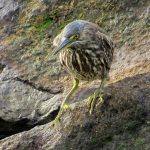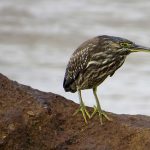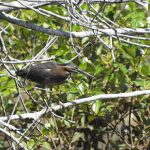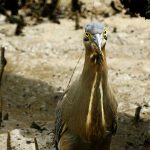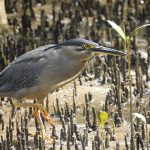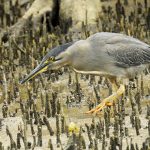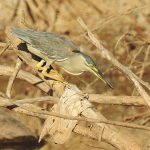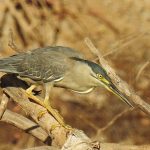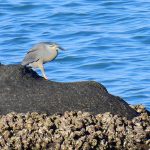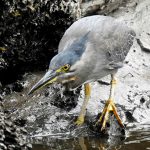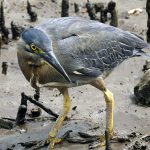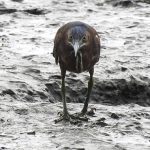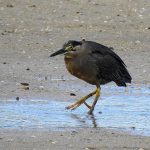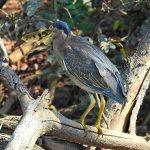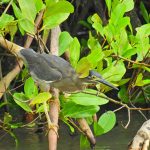STRIATED HERON
Striated Heron: The Stealthy Hunter of Australia’s Wetlands
Hidden among the twisting roots of mangroves and the still waters of estuaries, the Striated Heron quietly surveys its domain. With its keen eyesight and patient composure, this small heron is a master of survival in the complex mosaic of Australia’s coastal and inland waterways.
Vivid Description
Imagine standing at the edge of a quiet mangrove forest at dawn. The air is thick with the scent of brine and damp earth, your ears filled with the distant chatter of shorebirds. Through a curtain of green, a slender bird about the length of your forearm—44 to 47 centimetres—emerges. Its feathers are a subtle tapestry of grey-blue, olive, and delicate streaks along its neck and chest, lending it the “striated” name. Its sharp, yellow eyes scan the water, while long, slender toes grip a mossy branch above the shallows.
Behaviour and Ecology
Skilled and Patient Hunter
The Striated Heron is a model of patience. It stands motionless at the water’s edge, blending into the shadows. The only movement is the gentle ripple of water and the soft rustle of mangrove leaves. Suddenly, with swift precision, it darts its beak into the water, emerging with a wriggling fish or crustacean. Its diet is varied—small fish, amphibians, insects, and crustaceans—whatever the wetland offers.
| Prey Type | Example |
|---|---|
| Fish | Small mullet, gobies |
| Crustaceans | Crabs, shrimps |
| Insects | Water beetles, aquatic larvae |
| Amphibians | Small frogs |
Nesting and Family Life
In the dense embrace of mangrove trees, Striated Herons weave their nests from sticks, tucking them safely above the water. Here, the story of new life unfolds. During breeding season, the air is punctuated by the high-pitched, squeaky calls of chicks—sounds reminiscent of children’s toys. These calls help parents locate their young among the thick foliage.
Adaptability and Distribution
Striated Herons are found across northern and eastern Australia, thriving in:
- Coastal mangroves
- Estuaries
- Wetlands
- Urban ponds and gardens
They are resilient birds, capable of adapting to various habitats, whether natural or shaped by humans. Some populations remain year-round, while others move with the seasons, following the rhythm of water levels and food abundance.
Social Structure
Though generally solitary, Striated Herons occasionally gather in loose colonies during the breeding season. These gatherings, sometimes just a few pairs, bring a sense of community to the otherwise secretive lives of these birds.
Conservation Message
Despite their adaptability, Striated Herons face challenges. The loss and degradation of wetlands, particularly through development and pollution, threaten their habitats. By protecting mangroves and wetlands, we ensure a future for these remarkable birds and the countless other species that share their world.
Related Species and Subspecies
Belonging to the heron family Ardeidae, the Striated Heron is a relative of the White-faced Heron, another familiar sight in Australian wetlands. Taxonomists recognise several subspecies of the Striated Heron, each with subtle differences in their appearance, a testament to their adaptability across a wide range.
Why Observe Striated Herons?
For birdwatchers and nature enthusiasts, watching a Striated Heron hunt is a lesson in patience and adaptation. Their quiet presence, intricate plumage, and fascinating behaviour offer a unique window into the delicate balance of Australia’s wetland ecosystems.
Final Thought
The next time you find yourself near a still estuary or a sun-dappled mangrove, pause and listen. You might just hear the gentle “squeak” of a Striated Heron chick, or spot the silent silhouette of an adult waiting for its next meal. In every encounter, there is a story of survival, adaptation, and the enduring beauty of Australia’s wild places.
Photo Gallery
Sharon:I often see Striated Herons when walking along our shorelines, where they enjoy fishing. I have also seen them fishing on our inland rivers in Queensland. Wherever I see them they are always concentrating sooo hard on attempting to catch a fish, that it makes them easier for me to photograph. Have a Peek at the younger Heron with his beautifully striped plumage.

